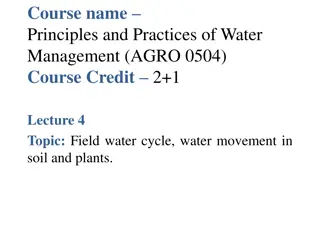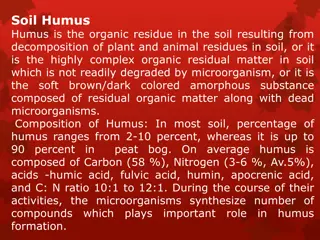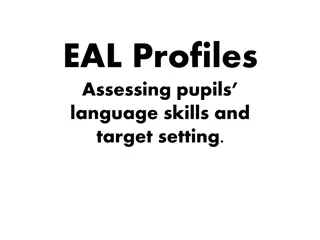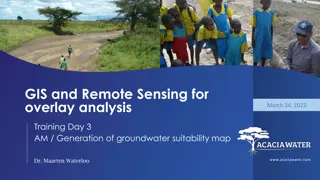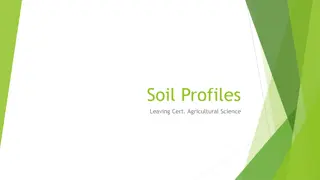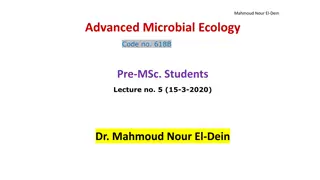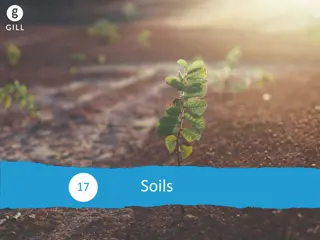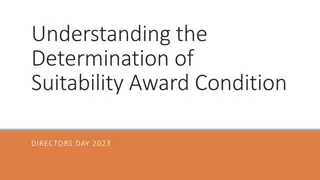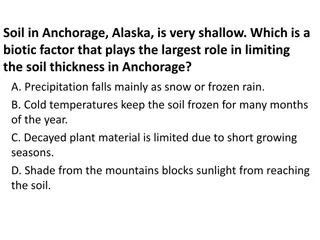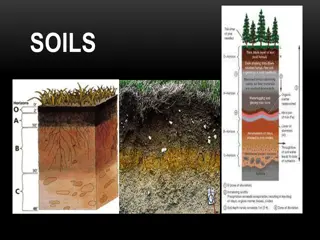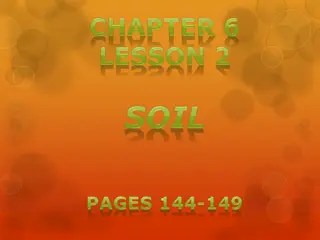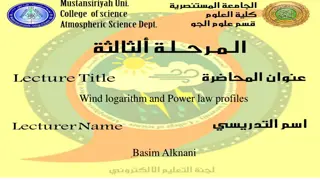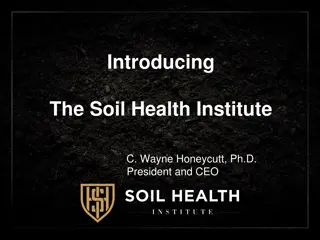Importance of Describing Soil Profiles for Soil Suitability Analysis
Proper classification and interpretation of soil properties through describing soil profiles are essential in determining soil suitability for various uses. Soil classification involves describing, classifying, and interpreting soil properties to understand the best uses and limitations of the soil. Dichotomous keys are valuable tools used in soil taxonomy exercises for determining characteristics such as epipedon and soil order. The simplified diagnostic horizon keys help identify key soil features like mineral composition, organic matter content, and basic saturation levels. Understanding endopedon characteristics including eluvial and illuvial horizons with specific criteria aids in soil profile analysis and classification.
Uploaded on Sep 30, 2024 | 2 Views
Download Presentation

Please find below an Image/Link to download the presentation.
The content on the website is provided AS IS for your information and personal use only. It may not be sold, licensed, or shared on other websites without obtaining consent from the author.If you encounter any issues during the download, it is possible that the publisher has removed the file from their server.
You are allowed to download the files provided on this website for personal or commercial use, subject to the condition that they are used lawfully. All files are the property of their respective owners.
The content on the website is provided AS IS for your information and personal use only. It may not be sold, licensed, or shared on other websites without obtaining consent from the author.
E N D
Presentation Transcript
Why Describe Soil Profiles? Why Describe Soil Profiles? There are no reliable interpretations of soil suitability without proper classification of the soil. And There is no reliable classification without description of soil properties. Therefore, In order to determine a soil s suitability for a given use we must describe, classify, and interpret the soil. Steps of Soil Classification 1. Describe Describe the soil to determine its properties. 2. Classify Use the described properties to classify the soil. 3. Interpret Use the soil properties to interpret best uses and limitations.
What is a Dichotomous Key? A Dichotomous Key: Asks a series of Yes-No questions in an inverted tree structure. The answer to one question determines the next question. Once passing a given question, users follow that branch to the end and ignore any questions from any other branches. Use the following Dichotomous keys with the Soil Taxonomy Exercise 2. The first key is used to determine the Epipedon. The second key is used to determine the Soil Order
Surface Mineral (Epipedon) simplified diagnostic horizon key (dichotomous) No Structure? Yes Color No Chroma 3 Value 3 ? Yes No Depth 25 cm ? Ochric Yes No SOM 1.0% ? Yes No BS 50% ? Umbric Yes Mollic SOM Soil Organic Matter BS Basic Saturation
Simplified Taxonomic Order key for Corn Belt Soils Yes Histic? Histosol More common in Northern Great Lakes Region: MI, MN, WI No Yes Spodic ? Spodosol No Yes Mollic? Mollisol Dominant soils in Corn Belt No Yes Ochric/umbric + Argillic , BS 35%? Alfisol No Yes Small, isolated areas anywhere, often associated with river systems Cambic? Inceptisol No Entisol Endopedon subsurface diagnostic horizon BS Basic Saturation
Endopedon Characteristics (simplified) Albic eluvial horizon Based mostly on color Chroma 2 & value 3 moist & 6 dry or 4 moist & 5 dry Or Chroma 3 & value 6 moist or 7 dry Spodic illuvial horizon pH 5.9 & SOC 0.6% Illuvial accumulation of organic carbon and aluminum with/without iron Appear redder or blacker or both than overlying horizon. Argillic illuvial horizon Illuvial accumulation of clay Amount of clay increase depends upon texture, minimum 3% or 1.2 x clay of overlying layer Cambic illuvial horizon Some evidence of soil development: structure or color changes from parent material Does not meet characteristics for other endopedons


